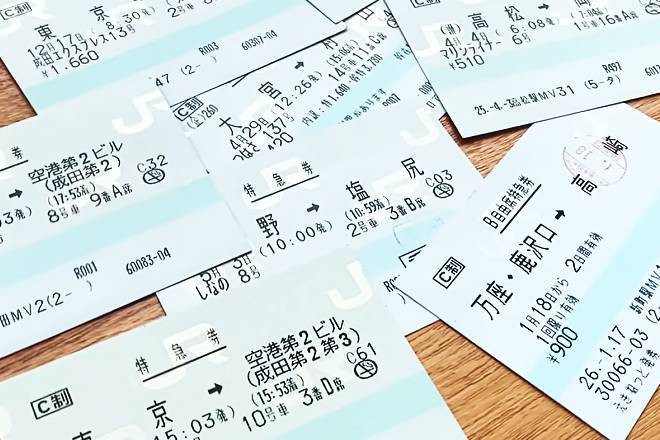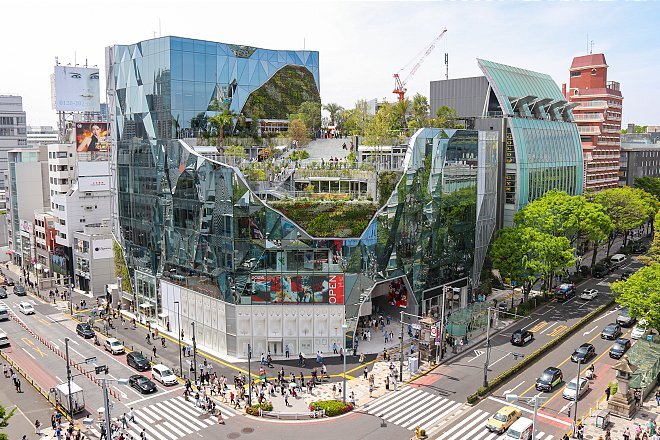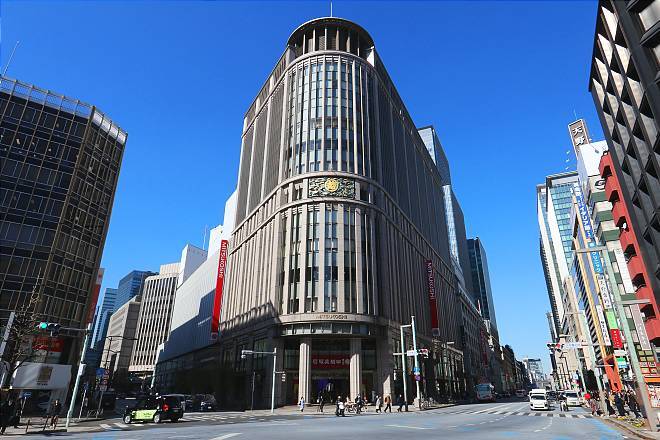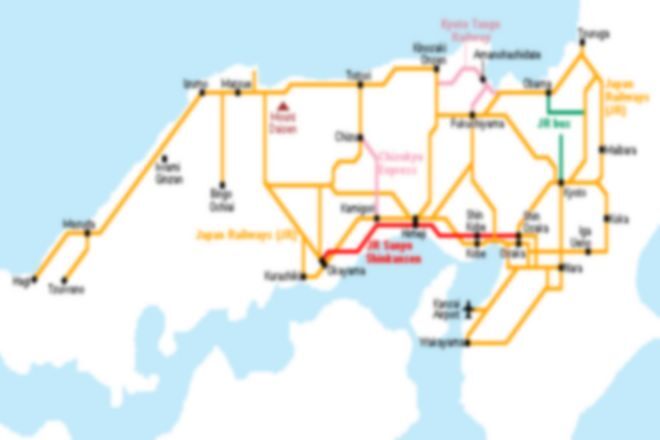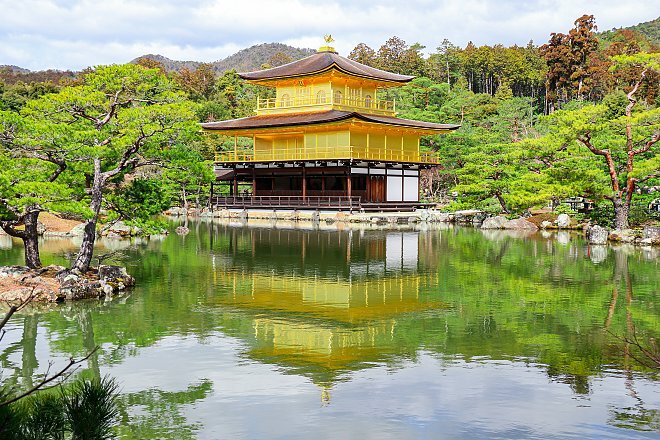Travel high along the JR Koumi Line

Surrounded by mountains - Mount Asama in the north, the Yatsugatake mountain range in the west and the Chichibu Tama Kai National Park in the southeast - the rural JR Koumi train line is a treat for those who enjoy scenic train rides and traveling at a slow pace. Diesel trains connect Kobuchizawa in the south to Komoro in the north through the countryside, affording mountain views and even Mount Fuji when the weather is clear.
Affectionately nicknamed the Yatsugatake Highland Line for the Yatsugatake mountain range, the Koumi Line operates on a relatively high elevation and contains the top five highest train stations in all of Japan. Nobeyama Station, the highest train station on the route and in the country, has an elevation of 1345.7 meters, while Saku Hirose Station is the fifth highest at 1073.5 meters. Komoro Station, the northern terminal station, has the lowest elevation at 663.4 meters, which is still higher than the 634 meter tall Tokyo Skytree!
On a fine summer's day in August, I set off on a day trip taking the Koumi Line from north to south and explored some of the attractions along the route. My journey started from Sakudaira Station, which is also a stop on the Hokuriku Shinkansen, and I got off at Tatsuokajo and Nobeyama stations for some sightseeing, before arriving at Kobuchizawa Station, the southern terminal of the Koumi Line. This itinerary can also be started from Kobuchizawa Station.
Star-shaped fort and an old shrine
An approximately two hour walk or four leisurely hours if sightseeing time is included, takes visitors on a nice circuit visiting two former castle grounds, a centuries-old shrine and a nice stroll through the rural countryside. I started from Tatsuokajo Station, which is named after the castle that used to stand in the area, and walked about 20 minutes to my first spot, the Tatsuokajo Goryokaku.




Tatsuoka Castle's biggest attraction is its unique star-shaped fortification, which is one of only two star-shaped fortresses in Japan. The other star-shaped fortress is the famous Fort Goryokaku in Hakodate, Hokkaido. For the construction of Tatsuokajo's Goryokaku, the last feudal lord of the region took inspiration from the existing fortifications in Japan, which mostly defended against intruders from the sea, like the daiba forts in Edo (now Tokyo) and Osaka as well as Hakodate's fortress. Construction began in 1864, the year Hakodate's Goryokaku was completed, and ended in 1867.
However, the new fort did not see much use as the Shogunate was overthrown in 1868, which marked the end of Japan's feudal period and started a new chapter in Japanese history. Castles and their associated structures were ordered to be demolished, and Tatsuokajo Castle was not spared. The castle grounds and stone foundations, however, were spared, and an elementary school, which held its last class in March 2023, occupied the space instead. Today, visitors can see the star-shaped stone fortifications and an old castle kitchen building.




I had a nice time strolling along the moat and seeing the former elementary school building. I wondered if the children who studied there loved their star-shaped school grounds. From there, I made my way to the observation deck, which was approximately 30 minutes on foot uphill to see the star-shaped moat from above. Interestingly, the observation deck is on the grounds of the former Taguchi Castle, which was constructed in the 16th century by a wealthy landowner named Taguchi who was then annihilated in the mid 16th century during the age of civil wars. Subsequent conquerors of the land suffered similar fates, and the castle was finally destroyed in the same century. Only a small stone carving marks the location of Taguchi Castle.
The walk from the grounds of Tatsuokajo Goryokaku to the entrance of the trail to the observation deck was straightforward, and I soon found myself walking up the side of a mountain. There were few signs pointing the way to the observation deck, but at no point did I feel like I was on the wrong route. However, I would not recommend walking to the observation deck if it had been raining heavily the day before or on the day of visit as it could be extremely slippery and there are no guard rails. On the dry summer day when I was there, the barely visible trail was covered with leaves and small rocks.
The view from the observation deck was worth the 30 minutes of uphill walking. I could see the Yatsugatake mountain range, the rice fields in the plains, and of course, the star-shaped fort. From the observation deck, the hiking route supposedly continues in the direction of my next spot, but without clear markings and signs, I decided that it was safer to return the same way and walk along the main road instead.






Going back down was a lot faster than walking up, and I soon found myself at Shinkai-sansha Shrine. This peaceful and quiet shrine was a hidden gem, and reminded me of Togakushi Shrine in Nagano except on a smaller scale. As the "sansha" in the shrine's name suggests, there are three (san) main shrines (sha) here. They are the east, middle and west shrines, enshrining the three gods associated with the founding and development of the Saku region. It remains unknown when the shrine was established, but it is said that warriors like Minamoto Yoritomo in the 12th century and Takeda Shingen in the 16th century have worshiped at this shrine.
As a side note, the dance stage at Shinkai-sansha Shrine is said to be the inspiration for the shrine scene, in which the female protagonist prepares sake in a traditional way, in the hit anime movie "Your Name". Furthermore, the acclaimed director Shinkai Makoto, who made "Your Name" as well as other popular anime movies like "5 centimeters per second", was born and raised in Koumi, just 30 minutes away by train.
It was such a treat to walk through the shrine grounds, which also contain two Important Cultural Assets, the East Shrine and a three-story pagoda. I almost lost track of time and had to briskly walk to Usuda Station to catch the train to my next destination.








Nobeyama Radio Observatory and the highest point on Japan's railway network
Nobeyama Station, which is located at an elevation of 1345.67 meters above sea level, holds the distinction of being the highest station in entire Japan Railways network. Consequently, the station is promoted as a place you can get close to the stars by train. In addition to being the highest train station, Nobeyama is also home to the Nobeyama Radio Observatory, which operates an array of radio telescopes to observe outer space and is the only one of its kind in Japan.
Upon arrival at Nobeyama Station, I rented a bicycle and cycled about 15 minutes to the radio observatory. The cycling route was as straightforward as instructed by the old man at the rental shop who told me to "Go straight on this road, cross the train tracks and keep going straight. You will see it", and so it was.






One of the biggest questions I had was why Nobeyama Radio Observatory is situated where it is. The answer is that the relatively dry climate containing little water vapour, the presence of few artificial radio signals and generally good weather make Nobeyama a good candidate for radio astronomy. The radio observatory has been in Nobeyama for just over 40 years since 1982.
I was initially curious to know and see what I would find there, and for those looking for a more hands-on experience or a big lesson in astronomy, you might want to manage your expectations a little if you do not read Japanese. There are lots of radio telescopes to be seen, the biggest of them has an impressive diameter of 45 meters! I enjoyed my visit to the sprawling observatory immensely, and spent over an hour strolling in the public area.
Displays describing outer space and the functions of the telescopes can be seen along the visiting route, but all information is written in Japanese only. There is however, an English pamphlet about the facility as a whole. For an additional fee, visitors can watch a video about astronomy and radio astronomy, but note that English translations are not available.





Having gotten my fill of the unlikely and atypical Japanese scenery, I made my way out to the Japan Railways' highest point. Located about a 15 minute bicycle ride from Nobeyama Station, the highest point on Japan's railway network sits at an elevation of 1375 meters. As a reminder, Nobeyama Station stands at 1345.67 meters, and there is an elevation of 30 meters between the two points.
Just like that, I had spent 2.5 hours exploring Nobeyama, and it was time to return my rental bicycle and press on to my goal station. Kiyosato, the next stop after Nobeyama in the direction of Kobuchizawa, is known for its holiday homes and art museums, but I sadly did not have enough time to get off and explore. I arrived at the terminal station with 30 minutes to spare before my next train ride home.



On weekends and selected weekdays, the High Rail 1375 sightseeing train makes one round trip between Kobuchizawa and Komoro stations. 1375 refers to the maximum elevation the tracks reach. Taking the High Rail train, which was what I did, could be an alternative to returning to your starting station instead of making a loop.
This one day trip turned out to be more epic than I had expected, and filled with a bit of everything, from historical and cultural sites to scenic and extraterrestrial sights. This has got me planning my next trip, one that possibly involves hiking in the Yatsugatake mountain range and/or visiting the art museums in Kiyosato. I can't wait to go back, and hopefully this article inspired you visit sooner rather than later!





Getting there and around
The JR Koumi Line connects Kobuchizawa Station in the south to Komoro Station in the north. The one way journey between the terminals without getting off takes about two hours and costs 1340 yen. Note that IC cards cannot be used along the Koumi Line except at the three Suica-compatible stations: Kobuchizawa, Kiyosato and Nobeyama.
Kobuchizawa Station is served by the JR Chuo Line, and there are 1-2 limited express trains per hour to/from central Tokyo (about 120 minutes, 5320 yen one way to/from Shinjuku). Sakudaira Station, six stops south of Komoro Station, is served by the Hokuriku Shinkansen, and there are 1-2 bullet trains per hour to/from Tokyo.
This itinerary starts from Sakudaira Station to Kobuchizawa Station then returns to Sakudaira via the same way.
Central Tokyo to Tatsuokajo
Take the Hokuriku Shinkansen from Tokyo to Sakudaira (about 90 minutes, 6000 yen one way). Transfer to the JR Koumi Line and take the train bound for either Koumi or Kobuchizawa. Get off at Tatsuokajo Station (about 30 minutes, 210 yen one way from Sakudaira Station).
- Approximate walking times
- Tatsuokajo Station to Tatsuokajo Goryokaku castle grounds: 20 minutes, mostly flat
- Tatsuokajo Goryokaku castle grounds to Goryokaku observation deck: 30 minutes, mostly uphill
- Goryokaku observation deck to Shinkai-sansha Shrine: 30 minutes, downhill, then flat
- Shinkai-sansha Shrine to Usuda Station: 40 minutes, mostly flat
Usuda to Nobeyama
Take a train bound for Kobuchizawa and get off at Nobeyama Station (about 60 minutes, 770 yen one way)
Rental bicycles are available from the tourist information center beside Nobeyama Station from 9:00 to 16:30. Rental prices for regular city bicycles start from 500 yen for one hour, while prices for electric powered bicycles start from 1000 yen per hour.
- Approximate cycling times
- Nobeyama Station to Nobeyama Radio Observatory: 10 minutes, mostly flat
- Nobeyama Radio Observatory to Railway highest point: 20 minutes, mostly flat along the train tracks
- Railway highest point to Nobeyama Station: 15 minutes, mostly flat
Nobeyama to Kobuchizawa
Take a train bound for Kobuchizawa and get off at the last stop (about 30 minutes, 510 yen one way). IC cards can be used for this portion of the train journey.


